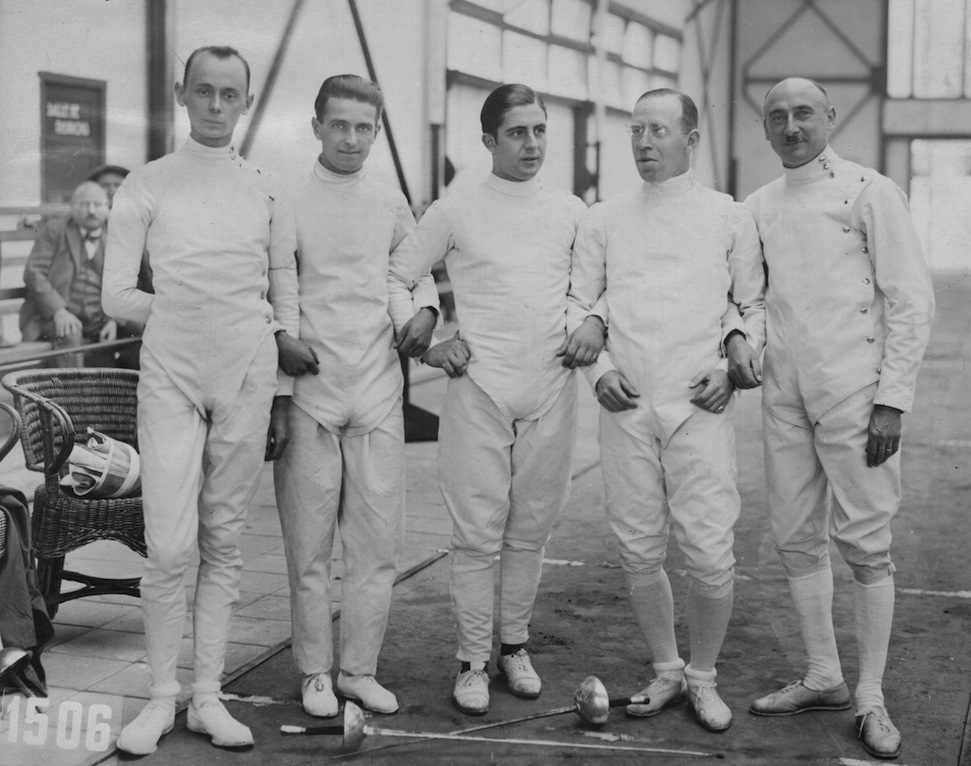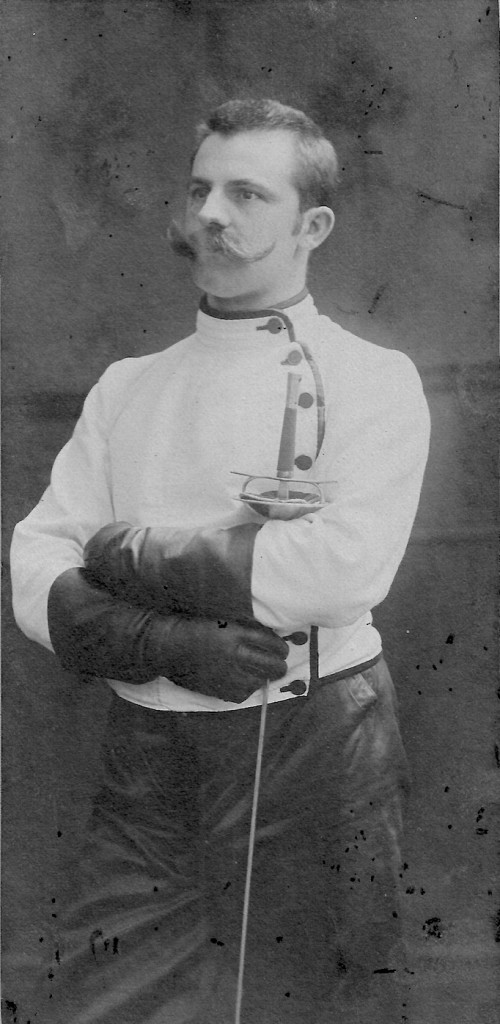I return to the pages of The Fencer today, to reprint (actually, re-type) an article written by Pierre Paret for the February, 1948 issue. A portrait of Hans Halberstadt.
Behind the Mask
Some years ago, a man who had taken a few lessons at the Young Italian Club of San Francisco before it was disbanded by the war, noticed that a shop which had long been for rent on Fillmore Street was again occupied. A sign painter was lettering “Halberstadt School of Fencing” on the door, and through the empty show windows he could see a middle aged woman being taught how to lunge by an improbable looking man in a red beret. He was not impressed by the new salle d’armes in fact, as he said later on, “I thought the whole thing was a fake and I went to my former teacher to find out what was going on.” He was very surprised when he was told that Halberstadt was not a fake but an international known fencer. He went back to Fillmore Street, started taking lessons, and is still with him. Except for a few routine clashes caused by their Latin and Teutonic temperaments, their relation has been a peaceful one.
In 1942, when Hans Halberstadt established his school, every new student was a blessing. During the first three months he had four, who would come twice a week and pay him fifty cents after each lesson. Occasionally one or the other didn’t have the change and Mr. Halberstadt would live on plums for the next few days. Very gradually more people came for instruction. Within a year he was able to enter teams in local competitions, but it was not until 1944 that he could consider himself soundly established.
Today he is one of the busiest teachers in the United States. Besides teaching at his school three afternoons and five evenings a week, he is also coach at the Olympic Club, where he works three times a week, and instructs at a theatrical academy at the Fairmont Hotel (twice a week), and at the YMCA (twice a week).
Hans teaching at the Elizabeth Holloway School, 1947
For a man who is sixty four years old this is a tough schedule to keep, and his friends have said for years that he should let up and take it easy. Some have even suggested that he import a young fencer from Europe who could serve as his boutmaster and handle the beginners, but international red tape and his conviction that he can handle anything this country can throw at him have squashed all such projects.
Unlike many fencing masters he does not restrict his work to giving lessons and straightening blades. He regularly fences with all of his students who have advanced to competition level. This work is considered by many fencers as one of the most valuable features of his teaching. At the same time it has also been the basis of rumor that he emphasizes competitive tricks while disregarding fundamental form and technique. This, however seems to be an accusation based on subjective thinking rather than a fact. He works his students on such fundamentals as footwork and profile as do most teachers in this country, but being above all a competitive fencer his main interest is continuity and purpose of action.
His competitive record is impressive. He represented Germany in sabre and epee in three Olympic Games, including Amsterdam in 1928 when he was a member of the sabre team which placed fourth. He has won international competitions in Milan, Munich, Vienna, Copenhagen, Ghent, Paris, Baden-Baden, Bad Neuheim, St. Moritz, Naples and Cremona. (He has a photograph over the sabre rack at his school showing Crown Prince Umberto presenting him with his trophy). He has three times won the German Three Weapon Championship, was champion of Germany in sabre once and epee twice, and was twenty-one times runner up in all three weapons to Erwin Casmir, who as the single male German entrant in the 1932 Olympics won fourth place in the Individual Sabre, and fifth in the Individual Foil.
Hans, 2nd from right, with some of his Olympic teammates, 1928.
Still, there have been many outstanding fencers who, after turning professional, were unable to communicate their knowledge to their pupils. The real test, the only test, of a fencing teacher lies after all in the fencers that he has produced. Halberstadt, who has been teaching for little more than six years, and has not had much time to produce really top-notch fencers, has nevertheless done quite well. He has developed many of the fencers who has received their early training from Maestro Visconti, an excellent teacher who learned fencing in Italy, and is now retired. One of them is Salvatore Giambra, member of the Olympic Training Squad in sabre. Another is Gerard Biagini, who despite his youth is already one of the most dangerous men in all three weapons in the Northern California Division. Probably his most promising early student was Ed Robles, who was killed in France. Since then his undeniably best pupil, whom he has developed from the start, is Louis Giorgi, who has been fencing little more than two years, but well enough to place second in the divisional Open Foil last season, to mention only one event.
Edward Visconti and Hans. Visconti retired as a fencing instructor and turned to glove making. All the best fencers used his gloves, including Aldo Nadi, who ordered them through Hans.
Halberstadt was trained from his early youth by Maestro Gazzera a well known representative of the Italian School as it has been systematized and laid down by such men as Parise and Barbasetti. Theoretically he has stuck strictly to this school, called “pure” by some fencers but actually he has modified the movements in the light of his competitive experience. This shows up clearly in his molinellos, which are made not out of his elbow but out of his wrist, or for instance in his belief that there are times when the left heel should be off the floor to give special sprint to the lunge.
Cavalaro Gazzera, from a photo inscribed to Hans in 1907.
He has not had much time for himself in the past few years. Sundays he enjoys driving into the country, but on weekdays he is forced to squeeze his recreation into the ever shrinking free time between giving lessons. He smokes from the moment he gets up until long after midnight, cigarettes, pipes and cigars; a three weapon smoker one might say. He has been known to give sabre lessons with a cigar stump still clenched in his teeth. Cigarettes he doesn’t like too much but they are convenient time indicators for intervals between giving lessons. He enjoys good foo and eats most of his meals at restaurants such as Solari’s, The Louvre, The Hotel des Alpes, and The Napoli. There, over a second cup of coffee, he will discuss the state of the nation, the rapacity of individuals, and their inability or unwillingness to learn from pas experience. Habitually he ends by saying, “Mein Gott, I know all this. I have been through all this before.” Sometimes he sits in his back room and drinks cognac or beer with Helene Mayer, a close friend who fenced for the same club as he in Germany, and some other cronies. Every year he used to give a birthday party for himself, and hundreds of costumed people, fencers and others, would dance on the fencing floor past the weapon racks and photograph covered walls. This year he broke the tradition and bought a Packard convertible coupe instead. Life, even as a fencing master in the United States… is
…..and that’s where it runs out. There are only about 5 or 6 more words to this article, but they are at the bottom of the page and the mimeograph failed to reproduce them faithfully. It is signed; that part is legible:
Paret
That would be Pierre Paret, the editor of The Fencer. Much of the information in this portrait of Hans is familiar, but it’s very nice to see a description from so early in his time in the US. Hans arrived from Germany in 1940 and taught until he passed away in 1966. There is one thing I wonder about, and that is the assertion that Hans was on 3 Olympic teams for Germany. Germany was banned from participation in both the 1920 and 1924 Olympic Games. In 1928, Hans was on the sabre and epee teams and competed in the individual epee. What I don’t know is whether German teams were selected for ’20 and ’24 even though they could not compete. Hans was certainly winning competitions in the early ’20’s, so he would undoubtably been a candidate for selection. The only certainty is that he was definitely on the 1928 team. (He was eliminated in the Semi-Finals of the individual epee.)






